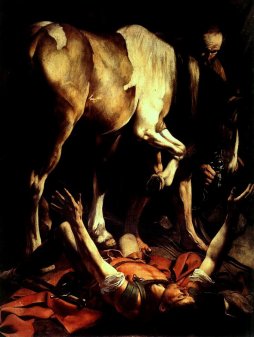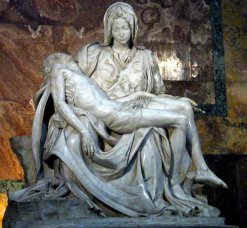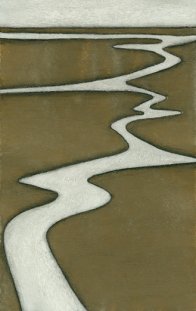In the spring of 1997, I was hired by the American Bible Society to open a gallery dedicated to biblical art. I had just received my PhD in medieval art from NYU, and, with student loans coming due, I was (unhappily) working on Wall Street, wondering how I ended up there and when I would be able to get back to the arts.
Then this opportunity came along: the president of the American Bible Society thought an art gallery could provide a new, appealing public face to the organization, while at the same time educating a wider public in the cultural importance of the Bible and its relationship to art. The prospect was intriguing. Working for the ABS, I would be free to curate exhibitions on a wide variety of subjects. On the other hand, I’d be starting from scratch, with few resources and no institutional reputation to build from. It sounded like a transitional job—the gallery seemed unlikely to succeed—but the experience of setting it up would help me eventually find a “real” job in the arts. I weighed my options: embrace the challenge, or stay on Wall Street. It was an easy choice.
The Gallery at the American Bible Society opened in the spring of 1998 with the mission of looking at art, religion, and culture in an attempt to understand how they influence each other. The gallery space was small, with imperfect climate control (which greatly limited the loans we could obtain) and little wall space, not to mention the unthinkable for an art gallery: wall-to-wall carpeting. But the ABS was generous with funding, and I was relieved and grateful to discover that former schoolmates at institutions near and far, as well as colleagues I’d never met, were willing to collaborate. Over the next six years the Gallery presented twenty-two exhibitions: quilts by African-American women, Russian icons, baroque sculpture, contemporary santos from Guatemala, Japanese prints, twentieth-century stained glass. To everybody’s surprise—most of all mine—an audience materialized, and even the press took notice. Soon I was in the position to hire another person: the staff had doubled overnight!
The Gallery was not always an easy sell: some were suspicious of a hidden proselytizing agenda; others heard “biblical art” and immediately assumed the work on display must be amateurish or undistinguished. And some of my friends expressed concern that I’d find the subject matter too restrictive. To most people, including professionals in the art world, “biblical art” has a very literal connotation: they imagine art that illustrates biblical stories or art found in Bibles. In fact, art that has its roots in the Bible is so pervasive in Western culture that we often fail to notice it. It includes what I call “biblical art beyond the biblical text”: subjects that reflect later religious texts (for instance, the legends of the saints or works by the church fathers) and interpretive commentary; art that originally functioned in a religious space; modern transformation of rituals and iconography; images rooted in a Judeo-Christian worldview but reflecting different times, societies, and particular cultures; and so on. There is an incredible wealth of art that can be traced, directly or indirectly, to biblical roots.
Appreciating religious art for more than its aesthetic qualities requires a certain level of biblical literacy that can no longer be assumed, even among educated people. Stephen Prothero’s eye-opening book Religious Literacy: What Every American Needs to Know—and Doesn’t points out that most American adults cannot name all four Gospels and that many high-school seniors think that Sodom and Gomorrah were husband and wife. Even in the academic world, biblical literacy is often neglected. The Bible is the single most influential book in the history of Western art, yet I was able to earn a PhD in medieval art without having to take any courses in religion or religious history.
 A friend told me this story: As he was gathering images for a lecture he was preparing, a fellow graduate student saw a reproduction of Caravaggio’s Conversion of St. Paul and asked, “Who’s this?” My friend began to talk about the greatest painter of the Italian Baroque, realism, chiaroscuro.... But his colleague interrupted him: “Of course I know who Caravaggio is. I meant, who is St. Paul?”
A friend told me this story: As he was gathering images for a lecture he was preparing, a fellow graduate student saw a reproduction of Caravaggio’s Conversion of St. Paul and asked, “Who’s this?” My friend began to talk about the greatest painter of the Italian Baroque, realism, chiaroscuro.... But his colleague interrupted him: “Of course I know who Caravaggio is. I meant, who is St. Paul?”
To answer that question with another question: How can one truly understand Caravaggio’s painting without grasping its symbolism, without knowing the story behind it and its historical consequences? Once we know that the painting illustrates Acts 9:3–8, the story of Saul’s vision of Christ on the road to Damascus and his subsequent conversion, and once we learn about St. Paul’s role in preaching the gospel and his extraordinary influence on Christian thinking, we start to understand this painting differently. It is not simply an artistic tour de force in the representation of man and horse, light and shadow, and a masterful example of foreshortening; it also depicts a transformative experience both for Saul and for Christianity.
When it comes to understanding much of Western art, the problem of biblical illiteracy is compounded by the fact that so much traditional, well-known iconography has its roots in a combination of literary sources and lived devotion. Knowledge of the Bible is an important starting point for understanding religious art, but history, legend, and other artistic achievements play equally important roles.
 Consider the Pietà, the iconic pose of the Virgin Mary holding the dead Christ on her lap, made most famous by Michelangelo’s glorious sculpture in St. Peter’s Basilica in Rome [right]. This image is a staple of Passion cycles and devotional images, an accepted part of the narrative sequence starting with the descent from the Cross and ending with the burial of Christ. Yet this moment is not described in any of the Gospels. Nor was it depicted in art until the late thirteenth century. Representations of the Pietà were made popular in the later Middle Ages through mystical writings that contemplated the suffering of Christ and his mother. From that time on, the subject became a favorite with artists—and found its place in the pantheon of biblical art.
Consider the Pietà, the iconic pose of the Virgin Mary holding the dead Christ on her lap, made most famous by Michelangelo’s glorious sculpture in St. Peter’s Basilica in Rome [right]. This image is a staple of Passion cycles and devotional images, an accepted part of the narrative sequence starting with the descent from the Cross and ending with the burial of Christ. Yet this moment is not described in any of the Gospels. Nor was it depicted in art until the late thirteenth century. Representations of the Pietà were made popular in the later Middle Ages through mystical writings that contemplated the suffering of Christ and his mother. From that time on, the subject became a favorite with artists—and found its place in the pantheon of biblical art.
The Pietà is one of many additions to the repertory of Christian art in the Middle Ages that were the direct result of changes in devotional practices. Many illustrate the desire for a more direct, personal participation on the part of the faithful—a new level of relating to the suffering of Christ and Mary. Understanding these changes in devotional life is crucial to appreciating innovations in devotional art produced at a given time.
After a few years at the gallery, a question started to nag at me: Is there a place in our culture for a stand-alone, independent museum of biblical art? More important, is there a greater need than the Gallery fills?
The answer became obvious. A stand-alone museum would reach a wider, more diverse audience; it would encourage partnerships; it would be a stronger voice in the cultural dialogue. With the support of the American Bible Society and a major grant from the Henry Luce Foundation, I was able to begin the process that ultimately resulted in the creation of the Museum of Biblical Art (MOBIA). The museum is separate from, but remains a strategic partner with, the ABS. It is housed in a fully renovated space on Manhattan’s West Side, just north of Columbus Circle, with a larger gallery and a museum-standard climate-control system that makes it possible to exhibit many more works.
MOBIA’s mission is to emphasize the religious and historical context that gives meaning to a painting like Caravaggio’s or a familiar image like the Pietà. Our exhibits demonstrate how art reflects the religion for which it was created, and how religious and devotional history forms the background for new developments in art. We try to link stories and symbols, paintings, and sculptures, with the religious, cultural, and political realities of the societies that created them.
 MOBIA’s official opening in May 2005 received considerable attention in the press, much of it slightly wary. The New York Times noted the difficulty of convincing “scholars, curators, and art lovers that this was intended to be a serious museum, not a glorified Sunday school or covert outpost of the religious right.” Since then, MOBIA has presented more than twenty exhibitions spanning multiple media, styles, and centuries. Subjects have included Albrecht Dürer and Marc Chagall, medieval art and biblical archeology, biblical movie posters and the contemporary, hand-illuminated Saint John’s Bible. An exhibit in spring 2010, “Uneasy Communion: Jews, Christians, and the Altarpieces of Medieval Spain,” focused on evidence of Jewish participation in the painting of Christian altarpieces. The New York Times, no longer wary, called it “a momentous turn in scholarly thought about Spanish art, [which] sheds light on a fascinating chapter in the history of the Jewish diaspora.”
MOBIA’s official opening in May 2005 received considerable attention in the press, much of it slightly wary. The New York Times noted the difficulty of convincing “scholars, curators, and art lovers that this was intended to be a serious museum, not a glorified Sunday school or covert outpost of the religious right.” Since then, MOBIA has presented more than twenty exhibitions spanning multiple media, styles, and centuries. Subjects have included Albrecht Dürer and Marc Chagall, medieval art and biblical archeology, biblical movie posters and the contemporary, hand-illuminated Saint John’s Bible. An exhibit in spring 2010, “Uneasy Communion: Jews, Christians, and the Altarpieces of Medieval Spain,” focused on evidence of Jewish participation in the painting of Christian altarpieces. The New York Times, no longer wary, called it “a momentous turn in scholarly thought about Spanish art, [which] sheds light on a fascinating chapter in the history of the Jewish diaspora.”
Each new MOBIA exhibition demonstrates the breadth of “biblical art.” That category stretches from the majority of works by great masters such as Rembrandt and Michelangelo to nonrepresentational paintings such as those by New York artist Tobi Kahn [see above], loosely based on the Genesis story of creation and intended for a synagogue sanctuary. In redefining biblical art, MOBIA introduces a new—and, I think, necessary—perspective to the art world, one that highlights how much the visual arts owe their symbolism, their message, their very existence to the Bible.
Related: Not for Iconoclasts, by Maurice Timothy Reidy
